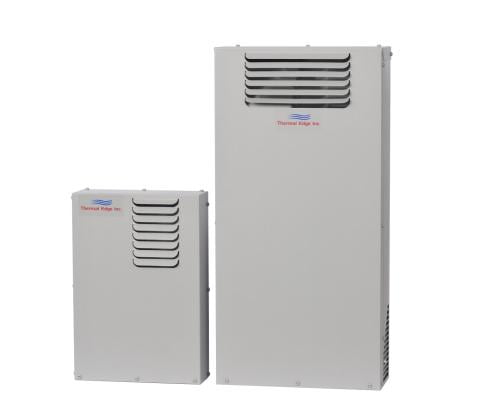How to Keep Industrial Air to Air Heat Exchangers Running Efficiently

An air to air heat exchanger is a robust piece of equipment with few components that can go wrong. If correctly maintained, it will provide years of trouble-free service. Here are several steps to take to keeping an air to air heat exchangers running efficiently.
Features of Air to Air Heat Exchangers
The heart of the heat exchanger is the heat pipe, which transfers heat from the cabinet to the ambient air. This pipe is fitted with aluminum fins to aid heat transfer. Hot air in the electrical enclosure is drawn into the heat exchanger by a small circulating fan. The hot air vaporizes the refrigerant inside the heat pipe, which cools the air that is returned to the enclosure. At the warm end of the pipe, known as the condenser, the refrigerant is condensed by ambient air circulated by a second fan. The heat that is removed is discharged away from the equipment and enclosure.
Crucial aspects to note are that the enclosure temperature is determined by the ambient air temperature, the enclosure head load, and capacity of the heat exchanger. The enclosure temperature should be slightly higher than the ambient temperature.
How to Ensure An Air to Air Heat Exchanger Runs Efficiently
Perform Regular Cleaning
Regular maintenance consists of removing any dirt that has accumulated on the blades of the circulating fan and on the aluminum fins of the heat pipe. This can be performed by using a soft water spray or blowing with clean, low-pressure compressed air. If the heat pipe fins are badly fouled, it may be necessary to remove the fan for better access.
Maintain Good Air Circulation
Should one of the fans fail, performance will be affected, so check that both fans are clean and running. Because an air to air heat exchanger is dependent on effectively moving air, make sure there are no obstructions that reduce the air flow inside the electrical enclosure and there is at least 5 inches of clear space around the condenser’s air inlet and return.
Keep the Enclosure Well Sealed
An air to air heat exchanger has a limited heat removal capacity, so it’s imperative there are no air leaks in the electrical enclosure that can allow air into the enclosure.
The enclosure door should close and seal properly. Make certain that the door latches engage securely and the seal is in good condition. Also verify that the gasket between the heat exchanger and the enclosure is in sound condition and is not allowing any air to leak through. Make sure the heat exchanger securing bolts are tight.
Additionally, verify that there’s no air leaking through conduit and cable gland entry points into the enclosure and that all other openings are properly sealed. If there are any small leaks, they can be sealed using a silicone-free Lexel sealant.
Control the Heat Load
It’s good practice to maintain an inventory of the equipment inside the enclosure and log any additional heat-generating equipment added to the enclosure. Any increase in the heat load will cause a corresponding increase in the electrical enclosure temperature, so any changes should be carefully managed and properly engineered.
Perform Regular Maintenance Inspections
Regularly monitoring the condition of an air to air heat exchanger will go a long way toward ensuring trouble-free operation. It is suggested that inspections are scheduled on a frequency relating to the environmental conditions where the enclosure is located.
Thermal Edge’s air to air heat exchangers offer an efficient closed loop cooling solution that’s a preferred alternative to filtered fans. Their low energy consumption, tolerance for dirty and polluted environments, and NEMA types 12, 4, and 4X ratings combine to offer a superior yet cost-effective solution. Contact our sales team to see how air to air heat exchangers will improve your enclosure cooling.


